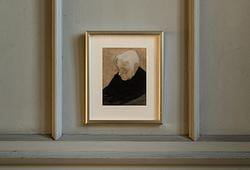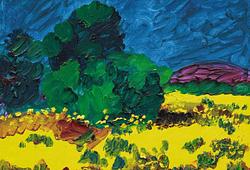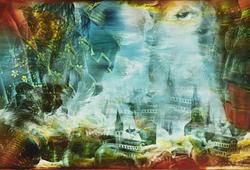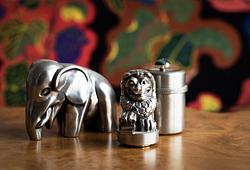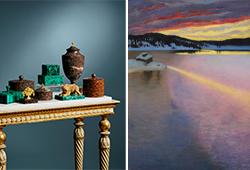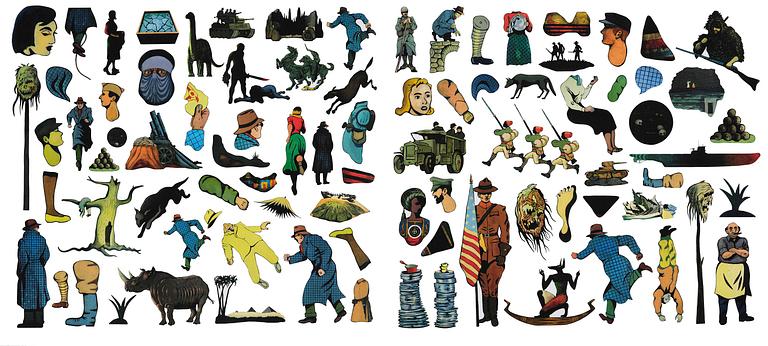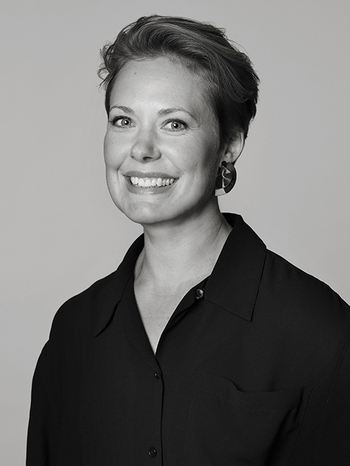Jan Håfström
"Den eviga återkomsten"
Signed Jan Håfström and dated 2003 verso.
86 painted wooden panels in varying size.
Alkuperä - Provenienssi
Bukowski Auktioner, Contemporary & Design 561, 18 May 2011, lot 458.
Private Collection, Sweden.
Näyttelyt
Baltic Art Centre, Visby, "Jan Håfström - Den eviga återkomsten", 20 September - 9 November 2003.
National Museum of Art, Warszawa, "Den eviga återkomsten", 2004.
Moderna Museet, Stockholm, "Moderna utställningen", 18 February - 7 June 2006.
Passagen Linköpings konsthall, Sweden, 16 August - 4 October 2008.
Liljevalchs konsthall, Stockholm, "Mörkrets hjärta", 18 April - 21 May 2009.
La Biennale di Venezia, 55rd International Art Exhibition "Making Words", Arsenale, 7 June - 22 November 2009.
Bohusläns museum, Uddevalla, "Jan Håfström, Den eviga återkomsten", 28 January - 4 March 2012.
Kirjallisuus
Baltic Art Centre, Visby. "Jan Håfström - Den eviga återkomsten", 2003, exhibition catalogue, illustrated.
Johanna Ekström and Niclas Östlind, "Jan Håfström - Den eviga återkomsten (The Eternal Return)", 2008, illustrated.
Liljevalchs konsthall, Stockholm, "Mörkrets Hjärta - Jan Håfström, 2009, illustrated.
La Biennale di Venezia, 55rd International Art Exhibition "Making Worlds", Arsenale, 2009, exhibition catalogue, illustrated.
Muut tiedot
Jan Håfström has, since the 1960s, developed a multifaceted and complex artistic practice that constantly seeks new paths. He has alternated between painting and installations, shifting between figurative and abstract painting, creating films, sculptures, and also working as an art critic.
A major source of inspiration for Håfström is literature. The work in this auction – “The Eternal Return” – has a connection to Joseph Conrad’s novel “Heart of Darkness”, published in 1902. At the same time, the title “The Eternal Return” refers to a concept found above all in Friedrich Nietzsche's work – a designation for the idea that world history repeats itself over and over again. Håfström also draws inspiration from comic strips, with the enigmatic Mr. Walker, known from the world of comics, at the center of events. Bukowski Auktioner is proud to present one of the most complex and magnificent artworks of our time.
Monica Nieckels, former curator at Moderna Museet, writes about Jan Håfström:
"They lay in a suitcase in the attic, Jan Håfström's pictures, hundreds of drawings depicting fantastic adventures and ideas about life and the world. Childhood landscapes with maps, places and events. His mother had saved them. The suitcase became a flying carpet, a joyful source and a memory bank from which to draw inspiration and travel back in time.
Since the 1960s, Jan Håfström has been an important and clearly shining star in Swedish art and cultural life. It was then that he graduated from the Royal Academy of Fine Arts in Stockholm and painted ‘Skogen’ (The Forest) in 1968 and later ‘Farmor’ (Grandmother) in 1972, both of which have become classics and have long been on display in the Moderna Museet collection.
He travelled to New York in the 1970s and initiated a major dialogue with all the new ideas in art, experimental film, dance, music, abstract expressionism and post-minimalism. He met Öjvind Fahlström, Gordon Matta Clark, Robert Smithson and others in a vibrant, dynamic art scene.
Håfström returned to Sweden and shared what he had seen and experienced. He presented new ideas and artistry of the time with deep dives into history and his own abstract works and texts.
Together with artist friends, he initiated the three ‘Ibid’ exhibitions, which were held in abandoned industrial premises (Linoljefabriken, Münchenbryggeriet, in Borås), thus moving outside the white cube and the monopoly of institutions as art venues and presenters. The Ibid exhibitions showed that contemporary art could take place outside the traditional framework. Art could be site-specific and enter into a different history and time. The experience of the context reinforced the significance and role of art as an actor in the world at large, outside the art scene. Seeing through the eyes of art provided a new perspective and a stronger sensibility.
Jan Håfström has often broken away and tried new things, moving away from conventions and boundaries. He writes art criticism, makes films, designs sets, paints and sculpts.
In 2001, he surprised the Swedish art audience with the exhibition ‘Walker,’ which made a huge impact at Färgfabriken in Stockholm. Out of the abstract, silent, minimalist emerges Mr Walker and his fictional, eventful world. Parts of childhood adventures and images depicting the disguised Mr Walker, alias Fantomen, can be found in the paintings. This time in the form of cut-out, enlarged details. Like backdrops that for once play the leading role, the stories and adventures return in fragments and form a new story about how it was and how it turned out.
But Walker also moves in the same world as A. Böcklin's ‘The Isle of the Dead’ from the 1880s and Joseph Conrad's ‘Heart of Darkness’ from 1902. In the darkness of Romanticism, death is fought and the creative power of life wins and triumphs. In the story of Walker, Håfström combines the abstract canvases and the moods of the objects with the stories that have been decisive and strongly influenced his life. The journey of childhood returns in a stripped-down and renewed form.
Two years later, in 2003, at the Baltic Art Centre in Visby on Gotland, ‘The Eternal Return’ emerged. Here, the actors from the paintings have been freed and left the earth. The walls were filled and the silent rooms were populated, and the game began...
So in 2009, Liljevalchs' ‘Heart of Darkness’ unfolded in a large painting installation that took over the exhibition halls. The game continued with changed roles in old and new stories. The audience could participate and influence the characters' roles and movements. The painted figures had taken over the rooms, walls and ceilings. But as soon as the exhibition doors closed, parts of the works were loaded into cars and driven away to the 53rd Venice Biennale in 2009.
This was the fourth time Jan Håfström participated in the Biennale (1980, 1990, 2003 and 2009), a feat achieved by few Swedish artists. Håfström felt at home in Venice where history coexists with the present. It is easy for a visitor to travel between centuries, and the old masters are always present. Museums and exhibitions fill the old palaces, and 'if you get tired, you can sneak in and look at paintings by Titian and Tintoretto' (J.H.).
The working title of the Biennale installation was 'Paradise Lost', but eventually it was renamed. The work 'The Eternal Return' from 2003 is based on the original 'Paradise Lost' which has lived on and been expanded. Jan Håfström fulfills his contract with life and continues to tell his story. Mr Walker leads and entices him further."
Monica Nieckels
Jan Håfström "Den eviga återkomsten" installation view from "Mörkrets Hjärta", Liljevalchs konsthall, 2009. Photo: Andy Liffner.
Taiteilija
Ever since the 60s, Jan Håfström has been an important and clearly shining star in Swedish art and culture. He graduated from the Academy of Fine Arts in Stockholm and painted "The Forest", 1968 and later "Grandmother", 1972, both of which have become classics and can be seen in the Moderna Museet's collection.
In 2001, he surprised the Swedish art public with the exhibition "Walker", at Färgfabriken in Stockholm. Out of the abstract, quiet, minimalist comes Mr. Walker and his fictitious, eventful world. Elements of childhood adventures and images depicting the disguised Mr. Walker aka the Phantom are in the paintings. This time in the form of cut-out, enlarged details. Like scenery that for once has the main role, the stories and adventures return in fragments and form a new story, about how it was and how it came to be. But Walker also moves in the same world as A. Böcklin's "Island of Death" 1880s and Joseph Conrad's "Heart of Darkness" from 1902. In the darkness of romance, death is fought and the creative power of life is allowed to win and triumph. In the story about Walker, Håfström combines the abstract canvases and the moods of the objects with the stories that were decisive and strongly influenced his life. The journey of childhood comes back in stripped down and renewed form.
Lue lisää



